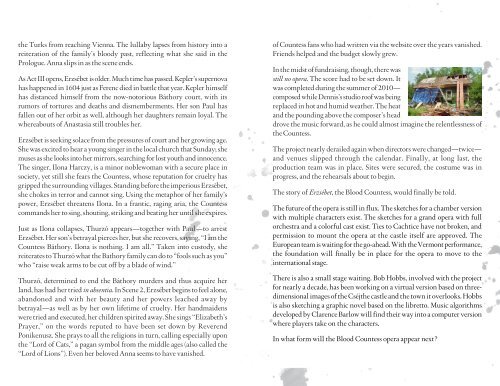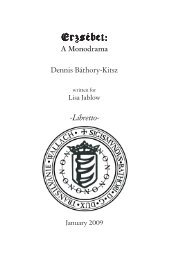Bolder Sounds 20 years of creative sample libraries - Báthory Erzsébet
Bolder Sounds 20 years of creative sample libraries - Báthory Erzsébet
Bolder Sounds 20 years of creative sample libraries - Báthory Erzsébet
You also want an ePaper? Increase the reach of your titles
YUMPU automatically turns print PDFs into web optimized ePapers that Google loves.
the Turks from reaching Vienna. The lullaby lapses from history into a<br />
reiteration <strong>of</strong> the family’s bloody past, reflecting what she said in the<br />
Prologue. Anna slips in as the scene ends.<br />
As Act III opens, <strong>Erzsébet</strong> is older. Much time has passed. Kepler’s supernova<br />
has happened in 1604 just as Ferenc died in battle that year. Kepler himself<br />
has distanced himself from the now-notorious <strong>Báthory</strong> court, with its<br />
rumors <strong>of</strong> tortures and deaths and dismemberments. Her son Paul has<br />
fallen out <strong>of</strong> her orbit as well, although her daughters remain loyal. The<br />
whereabouts <strong>of</strong> Anastasia still troubles her.<br />
<strong>Erzsébet</strong> is seeking solace from the pressures <strong>of</strong> court and her growing age.<br />
She was excited to hear a young singer in the local church that Sunday; she<br />
muses as she looks into her mirrors, searching for lost youth and innocence.<br />
The singer, Ilona Harczy, is a minor noblewoman with a secure place in<br />
society, yet still she fears the Countess, whose reputation for cruelty has<br />
gripped the surrounding villages. Standing before the imperious <strong>Erzsébet</strong>,<br />
she chokes in terror and cannot sing. Using the metaphor <strong>of</strong> her family’s<br />
power, <strong>Erzsébet</strong> threatens Ilona. In a frantic, raging aria, the Countess<br />
commands her to sing, shouting, striking and beating her until she expires.<br />
Just as Ilona collapses, Thurzó appears—together with Paul—to arrest<br />
<strong>Erzsébet</strong>. Her son’s betrayal pierces her, but she recovers, saying, “I am the<br />
Countess <strong>Báthory</strong>. Ilona is nothing. I am all.” Taken into custody, she<br />
reiterates to Thurzó what the Bathory family can do to “fools such as you”<br />
who “raise weak arms to be cut <strong>of</strong>f by a blade <strong>of</strong> wind.”<br />
Thurzó, determined to end the <strong>Báthory</strong> murders and thus acquire her<br />
land, has had her tried in absentia. In Scene 2, <strong>Erzsébet</strong> begins to feel alone,<br />
abandoned and with her beauty and her powers leached away by<br />
betrayal—as well as by her own lifetime <strong>of</strong> cruelty. Her handmaidens<br />
were tried and executed, her children spirited away. She sings “Elizabeth’s<br />
Prayer,” on the words reputed to have been set down by Reverend<br />
Ponikenusz. She prays to all the religions in turn, calling especially upon<br />
the “Lord <strong>of</strong> Cats,” a pagan symbol from the middle ages (also called the<br />
“Lord <strong>of</strong> Lions”). Even her beloved Anna seems to have vanished.<br />
<strong>of</strong> Countess fans who had written via the website over the <strong>years</strong> vanished.<br />
Friends helped and the budget slowly grew.<br />
In the midst <strong>of</strong> fundraising, though, there was<br />
still no opera. The score had to be set down. It<br />
was completed during the summer <strong>of</strong> <strong>20</strong>10—<br />
composed while Dennis’s studio ro<strong>of</strong> was being<br />
replaced in hot and humid weather. The heat<br />
and the pounding above the composer’s head<br />
drove the music forward, as he could almost imagine the relentlessness <strong>of</strong><br />
the Countess.<br />
The project nearly derailed again when directors were changed—twice—<br />
and venues slipped through the calendar. Finally, at long last, the<br />
production team was in place. Sites were secured, the costume was in<br />
progress, and the rehearsals about to begin.<br />
The story <strong>of</strong> <strong>Erzsébet</strong>, the Blood Countess, would finally be told.<br />
The future <strong>of</strong> the opera is still in flux. The sketches for a chamber version<br />
with multiple characters exist. The sketches for a grand opera with full<br />
orchestra and a colorful cast exist. Ties to Cachtice have not broken, and<br />
permission to mount the opera at the castle itself are approved. The<br />
European team is waiting for the go-ahead. With the Vermont performance,<br />
the foundation will finally be in place for the opera to move to the<br />
international stage.<br />
There is also a small stage waiting. Bob Hobbs, involved with the project<br />
for nearly a decade, has been working on a virtual version based on threedimensional<br />
images <strong>of</strong> the Cséjthe castle and the town it overlooks. Hobbs<br />
is also sketching a graphic novel based on the libretto. Music algorithms<br />
developed by Clarence Barlow will find their way into a computer version<br />
where players take on the characters.<br />
In what form will the Blood Countess opera appear next?



